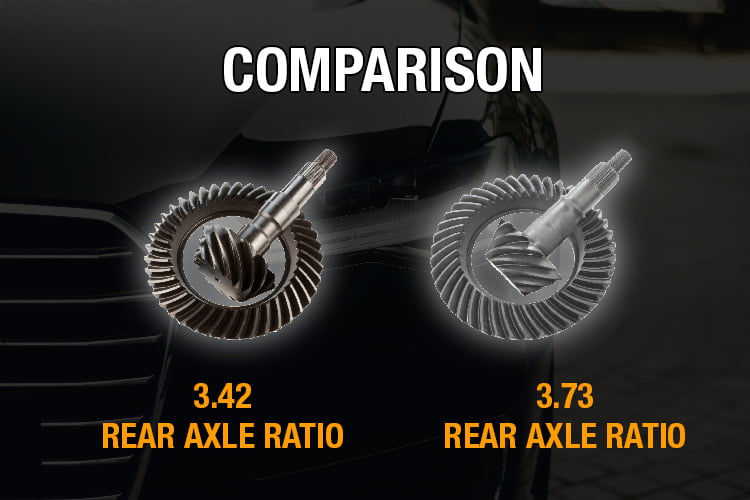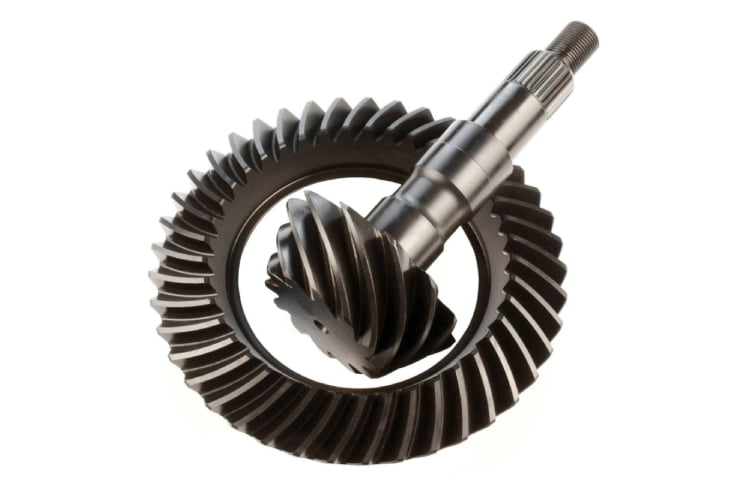Also referred to as the gear ratio, the ratio of the rear axle substantially impacts a vehicle’s power. Generally speaking, this ratio indicates the number of rotations an axle makes to generate one complete rotation of the wheels. The ratio can be calculated by dividing the count of the ring gear’s teeth by the count of pinion teeth.
For most trucks, the axle ratio ranges from 3 to 4. But in this article, we will compare the 3.42 Vs. 3.73 rear axle ratio. We’ll also discuss some of the essential things you should know about gear ratios.

Understanding Axle Ratios
What Is The Axle Ratio?
The axle ratio connotes the gears in a truck’s differential connecting the rear axle to the engine’s output shaft. It represents the number of rotations a driveshaft has to make to spin the axle in one complete turn.
This ratio is usually expressed technically as a ratio such as 3.42:1. Thus, implying that the driveshaft has to turn 3.42 times to cause a single wheel rotation. The value is generally expressed without the ratio symbol, so “3.42:1” would commonly be referred to as “3.42”.
The gear ratio may seem technical to the average car owner, but there’s nothing overly complicated about how it works.
You should know that the higher the numerical value, the higher the towing power and fuel consumption. As the axle ratio increases, more torques become available for the rear tires and front tires in four-wheel drives. With this advantage, however, comes a reduction in fuel economy.
How To Calculate Axle Ratio
Most contemporary differentials feature stickers or bolted plates printed on different details, including the axle ratio. Sometimes, it can be pretty hard to retrieve this information as the sticker could have peeled off or the plate rusted. In this case, there’s another way to calculate the axle ratio.
The simple formula involves dividing the number of ring gear’s teeth by the number of pinion’s teeth. You would have to get under the vehicle and take apart the differential. And afterward, count the number of teeth on the ring gear as well as that on the pinion.
There’s another way to calculate your axle ratio. Raise the vehicle with a jack and place heavy-duty jack stands on both sides of the rear axle housing. Mark a line along with the driveshaft with chalk and mark another on the tire. Ensure that both marks can line up easily.
Rotate the tire counterclockwise. Pay attention to the number of times the driveshaft rotates as the tire makes one complete revolution.
For example, if the drive shaft rotates four and a half times, the axle ratio is 4.50:1 or simply 4.50. You may need an assistant to help you count the number of rotations you turn the tire.
The Importance Of Axle Ratio
The axle ratio is not just numerical data, but it determines important metrics like torque, towing capacity, fuel economy, and more.
The higher the numerical value of the gear ratio, the higher the acceleration and torque you can expect. This is why you’ll see heavy-duty trucks and race cars with comparatively higher gear ratios.
However, that increase in power and acceleration is directly related to increased fuel consumption and a reduction in top speed.
On the other hand, a lower axle ratio will improve fuel economy. Nevertheless, it may not offer the enhanced performance benefits that many truck owners would want.
It’s essential to understand the axle ratio when buying a truck or upgrading one you already own. It will help you choose the right axle that fits into what you plan to use your truck for.
Read more: 10 Best Aftermarket CV Axles With $100 [2022 Review & Buying Guide]
The Differences Between 3.42 And 3.73 Rear Axle Ratio
What Is A 3.42 Rear Ratio Good For?

Source: motivegear.com
A lower numeric axle ratio like 3.42 may reduce the intensity of work a vehicle’s engine has to do. When cruising at normal highway speeds, fuel economy is enhanced.
It makes much sense if all you do is daily commute in the city or fairly regular highway driving. The 3.42 turns of the pinion for every turn of the crown gear will give better fuel mileage.
This is the optimal gear ratio for vehicles like the Canyon V-6 and Sierra 1500 models.
What Is A 3.73 Rear Ratio Good For?

Source: motivegear.com
If you will be towing some heavy-duty load or trailers, or if you prefer to have a more spirited feel in acceleration, you might be better off with a higher numeric axle ratio like 3.73.
This comparatively higher ratio provides more low-speed wheel torque, making it easier to get the truck moving.
The Chevy Silverado, GMC Sierra half-ton trucks, and some other GM trucks are some vehicles that should use 3.73 rear axles.
Read more: Ford Axle Code Chart: Everything You Need To Know
3.42 Vs. 3.73 Rear Axle Ratio, Which One Is Better?
The best gear ratio for you is dependent on what you’re looking to get out of your vehicle.
If you do more of regular city navigation and normal highway driving, with the occasional heavy-duty stuff, the 3.42 will suffice. Furthermore, you will get better gas mileage for everyday driving.
However, if quick acceleration and heavy-duty towing ability are things you’re looking for, the 3.73 is your ideal choice. Although the 3.42 axle ratio does a good enough job many a time, it just is not as heavy-duty as the 3.73.
Having a higher numerical axle ratio will ensure you have more power, but it will cause a reduction in your top speed. While you may not go as fast, you can expect an enhanced initial acceleration.

USA Standard Gear (ZG GM8.5-342)

USA Standard Gear (ZG GM8.5-373)
Read more: Axle Seal Leak: Symptoms, Effects, And Replacement
How To Choose The Right Axle Ratio For Your Truck
Whether you’re out to buy a new truck or upgrade your old one, the axle ratio can be a pretty important choice you have to make.
Comparing axle ratios across different brands can be quite confusing, as tire sizes vary across different manufacturers. This is why you should compare optional axle ratios one car manufacturer at a time before making your final choice.
As a rule of thumb, the larger the axle ratio value, the quicker the truck will accelerate and the better the towing capabilities.
You may be tempted to conclude that the enhanced performance of higher gear ratios means they’re better than lower gear ratios. Nevertheless, that’s not so valid. For instance, a truck with a 3.31 axle ratio will boast better fuel economy than a 3.55 truck.
Overall, it comes down to what specific needs your truck has and what you intend to do with your truck. When you need to haul heavy loads, you need as much torque and pulling power as you can get. Upgrading to a higher ratio can get you that.
Read more: CV Axle Boot: Overview, Signs, And Replacement
Conclusion
Think about your navigation and hauling needs before picking a new truck or making significant updates to the one you already own. There’s an axle ratio ideal for every use case. So you should choose based on how much load you’ll regularly tow while also paying attention to fuel economy.
There’s no definite answer to the question of whether one axle ratio is better than the other. What matters is which option suits you and your needs best.
